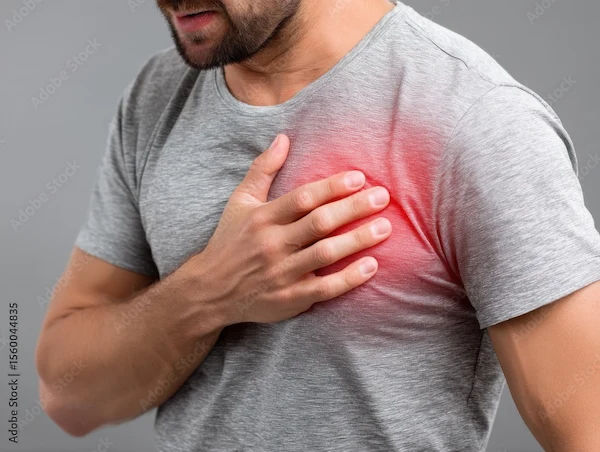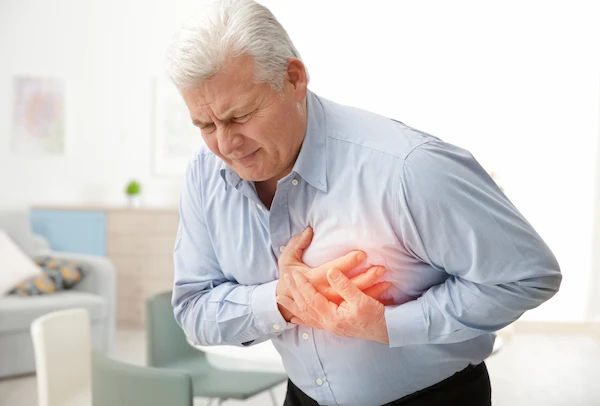Silent Heart Attack: Signs, Symptoms, and Why They're Often Missed
Know about the silent heart attack, signs, symptoms, difference from regular heart attack, signs, symptoms, diagnosis, risk factors and treatment options and more.


Introduction
Imagine having a serious medical event that damages your heart muscle, but you never feel the classic, dramatic chest-clutching pain you see in movies. You might dismiss it as indigestion, a pulled muscle, or simply a bad day. This is the reality of a silent heart attack, a surprisingly common and dangerously overlooked health crisis. Because the symptoms of a silent heart attack are so vague and easy to attribute to other, less serious conditions, many people don't seek the urgent medical care they need. This article will guide you through the subtle signs, the populations most at risk, and the critical steps for diagnosis and prevention, empowering you to protect your heart health by understanding these hidden warnings.
What Exactly is a Silent Heart Attack?
A silent heart attack occurs when blood flow to a part of the heart is blocked, just like in any other heart attack. The key difference lies not in the event itself, but in how the body—and the person—perceives it. In a classic heart attack, the blockage causes intense symptoms like severe chest pain, radiating arm pain, and profuse sweating, triggering an immediate alarm. In a silent MI, the symptoms are either absent, so mild they are unnoticeable, or mistaken for something else entirely.
The underlying cause is always coronary artery disease, where plaque builds up in the arteries supplying the heart. When a piece of this plaque ruptures, a blood clot forms, obstructing blood flow. The heart muscle starved of oxygen begins to die, whether you feel dramatic pain or not. This is why understanding the symptoms of a silent heart attack is a matter of cardiac health literacy.
Consult a Cardiologist for Personalised Advice
How a Silent MI Differs from a Classic Heart Attack
The distinction is primarily in symptom presentation:
• Classic Heart Attack: Unmistakable, intense chest pain or pressure; pain radiating to the jaw, neck, back, or left arm; shortness of breath; cold sweat; nausea; lightheadedness.
• Silent Heart Attack: Symptoms are absent, subtle, or non-specific. They may include fleeting discomfort, unexplained fatigue, or a sensation that feels like heartburn or a flu-like illness.
Unmasking the Subtle Signs: Symptoms of a Silent Heart Attack
The challenge with a silent heart attack is that its "signs" are often whispers, not shouts. Learning to recognise these subtle cues can be life-saving.
Physical Sensations That Are Easy to Ignore
Instead of crushing pain, you might experience:
1. Discomfort in the centre of the chest: This can feel like a mild, lingering pressure, squeezing, or fullness that comes and goes.
2. Shortness of breath: Becoming winded after activities you could previously handle without issue, or feeling breathless for no apparent reason.
3. Discomfort in other areas: This is a key sign of a silent heart attack. You might feel a mild ache in the jaw, neck, back, or either arm (not just the left). It can be mistaken for a pulled muscle or arthritis.
Vague Symptoms You Might Misattribute
Many symptoms don't even register as heart-related:
1. Unexplained fatigue: A sudden, profound tiredness that isn't relieved by rest is a common symptom of a silent heart attack, especially in women.
2. Indigestion or nausea: A feeling of heartburn, stomach upset, or even vomiting can be the body's atypical response to cardiac distress.
3. Dizziness or lightheadedness: Feeling faint or unsteady on your feet without a clear cause.
4. A general feeling of being unwell: A sense of "something being off," sometimes described as having a bad cold or the flu.
Who is Most at Risk for a Silent Heart Attack?
While anyone with risk factors for heart disease can experience a silent MI, certain groups are disproportionately affected. The classic risk factors apply: high blood pressure, high cholesterol, smoking, obesity, a sedentary lifestyle, and a family history of heart disease.
The Elevated Risk for Women and Diabetics
Two groups require special mention:
1. Women: Studies show that women are more likely than men to experience silent heart attacks or present with non-traditional symptoms like fatigue, nausea, and back or jaw pain. Hormonal factors and differences in pain perception may play a role.
2. People with Diabetes: Long-term diabetes can lead to diabetic neuropathy, a type of nerve damage that can affect the nerves serving the heart. This can blunt the perception of chest pain, making a silent myocardial infarction more likely. For them, symptoms like sudden shortness of breath or unexplained fatigue are critical red flags.
How is a Silent Heart Attack Diagnosed?
Often, a silent heart attack is discovered weeks, months, or even years after the fact during a routine medical check-up. If your doctor suspects you may have had one, they will order specific tests.
The Role of an Electrocardiogram (ECG)
An ECG is the primary tool for detecting a past silent MI. It records the heart's electrical activity and can reveal tell-tale patterns that indicate areas of the heart muscle that have been damaged due to a lack of oxygen. These patterns are different from those seen during an active heart attack.
Blood Tests and Imaging Scans
It includes:
1. Blood Tests: While the standard troponin test (a protein released by damaged heart muscle) is used to diagnose an active heart attack, its levels return to normal within days or weeks. For an old event, other markers or a patient's history are more relevant.
2. Echocardiogram: This ultrasound of the heart can show areas of the heart wall that are not moving properly, suggesting prior damage.
3. Cardiac MRI: This provides highly detailed images of the heart muscle and can precisely identify scar tissue left behind by a past heart attack.
Get Your Symptoms Assessed
The Long-Term Consequences of an Undiagnosed Silent MI
The danger of a silent heart attack lies in the lack of treatment. Without knowing the event occurred, you and your doctor cannot take steps to manage the underlying coronary artery disease. This significantly increases the risk of:
1. A second, more severe heart attack: The initial damage weakens the heart.
2. Heart failure: The scar tissue from the attack impairs the heart's ability to pump blood efficiently.
3. Arrhythmias: Damage to the heart's electrical system can lead to irregular heartbeats.
This is why understanding the long-term effects of a silent heart attack underscores the importance of proactive heart health monitoring. If you experience any unusual, persistent symptoms, even if they seem minor, consulting a doctor online with Apollo24|7 for further evaluation is a prudent step.
Action Plan: What to Do If You Suspect a Silent Heart Attack
If you are currently experiencing symptoms that could be heart-related, even if they are mild, do not wait. Call emergency services immediately. Time is muscle when it comes to heart attacks.
If you are reflecting on past symptoms and wonder, "Can you have a heart attack and not know it?" the answer is yes. Schedule an appointment with your doctor or a cardiologist. Discuss your concerns, your risk factors, and any unexplained episodes of fatigue, discomfort, or breathlessness you may have had. Apollo24|7 offers convenient home collection for tests like cholesterol panels and HbA1c (for diabetes), which can be a great starting point for assessing your cardiac risk factors from home.
Strategies for Prevention: Protecting Your Heart Health
The best treatment for a silent heart attack is to prevent it from happening in the first place. The strategies are the same as for any heart disease:
1. Know Your Numbers: Regularly monitor your blood pressure, cholesterol, and blood sugar levels.
2. Adopt a Heart-Healthy Diet: Focus on fruits, vegetables, whole grains, lean proteins, and healthy fats while limiting processed foods, salt, and sugar.
3. Stay Active: Aim for at least 150 minutes of moderate-intensity exercise per week.
4. Don't Smoke: Smoking is a major risk factor for coronary artery disease.
5. Manage Stress: Chronic stress can contribute to high blood pressure and other risk factors.
Conclusion
A silent heart attack is a stark reminder that serious health issues don't always announce themselves with dramatic fanfare. The absence of classic, crushing chest pain does not mean an absence of danger. By familiarising yourself with the subtle signs—such as unexplained fatigue, mild chest discomfort, shortness of breath, or indigestion-like symptoms—you become empowered to act. Ignoring these whispers can have serious long-term consequences for your heart health. Prioritise regular check-ups, understand your personal risk factors, and most importantly, listen to your body. If something feels persistently wrong, even if you can't pinpoint it, seek medical advice. Your heart's silent plea for help is one you need to hear.
Consult a Cardiologist for Personalised Advice
Consult a Cardiologist for Personalised Advice

Dr. Syed Akram Ali
Cardiologist
14 Years • MBBS DCH DNB(PED) DNB(CARD) CONSULTANT INTERVENTOINAL CARDIOLOGIST, EUROPEAN SOCIETY OF CARDIOLOGY CERTIFIED HEART FAILURE SPECIALIST
Hyderabad
AYMAN POLYCLINIC, Hyderabad

Dr. Anand Ravi
General Physician
2 Years • MBBS
Bengaluru
PRESTIGE SHANTHINIKETAN - SOCIETY CLINIC, Bengaluru

Dr. Bhethala Sharan Prakash
General Physician/ Internal Medicine Specialist
5 Years • MBBS MD
Bengaluru
PRESTIGE SHANTHINIKETAN - SOCIETY CLINIC, Bengaluru

Dr. Sumanjita Bora
Cardiologist
9 Years • MBBS, PGDCC
Bengaluru
Apollo Clinic, Sarjapur Road, Bengaluru

Dr. Ramalinga Reddy
General Physician
5 Years • MBBS MD General medicine
Bengaluru
PRESTIGE SHANTHINIKETAN - SOCIETY CLINIC, Bengaluru
Consult a Cardiologist for Personalised Advice

Dr. Syed Akram Ali
Cardiologist
14 Years • MBBS DCH DNB(PED) DNB(CARD) CONSULTANT INTERVENTOINAL CARDIOLOGIST, EUROPEAN SOCIETY OF CARDIOLOGY CERTIFIED HEART FAILURE SPECIALIST
Hyderabad
AYMAN POLYCLINIC, Hyderabad

Dr. Anand Ravi
General Physician
2 Years • MBBS
Bengaluru
PRESTIGE SHANTHINIKETAN - SOCIETY CLINIC, Bengaluru

Dr. Bhethala Sharan Prakash
General Physician/ Internal Medicine Specialist
5 Years • MBBS MD
Bengaluru
PRESTIGE SHANTHINIKETAN - SOCIETY CLINIC, Bengaluru

Dr. Sumanjita Bora
Cardiologist
9 Years • MBBS, PGDCC
Bengaluru
Apollo Clinic, Sarjapur Road, Bengaluru

Dr. Ramalinga Reddy
General Physician
5 Years • MBBS MD General medicine
Bengaluru
PRESTIGE SHANTHINIKETAN - SOCIETY CLINIC, Bengaluru
More articles from Heart Attack
Frequently Asked Questions
1. Can you have a heart attack and not know it?
Yes, absolutely. This is the definition of a silent heart attack. It's estimated that nearly half of all heart attacks are silent, meaning the person may not recognise the symptoms at the time.
2. What does a silent heart attack feel like?
It may not feel like much at all, or it may feel like mild indigestion, a flu-like illness, unexplained fatigue, or a minor ache in the chest, jaw, or back. The sensations are often easy to dismiss.
3. How common are silent heart attacks in women?
Women are at a particularly high risk for silent heart attacks. They are more likely than men to experience non-traditional symptoms like nausea, vomiting, and back pain, which are often mistaken for other conditions.
4. What are the long-term effects of a silent heart attack?
The long-term effects are similar to a recognised heart attack and include an increased risk of heart failure, arrhythmias (irregular heartbeat), and a subsequent, more severe heart attack due to the untreated underlying heart disease.
5. How do doctors test for a past silent heart attack?
The most common test is an electrocardiogram (ECG or EKG), which can detect electrical patterns indicative of past heart muscle damage. An echocardiogram or cardiac MRI may also be used to visualise scar tissue.





